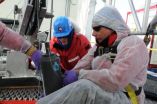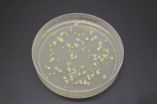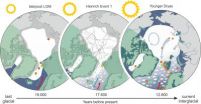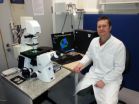800 meters beneath Antarctic ice sheet, subglacial lake holds viable microbial ecosystems
LSU's Brent Christner and colleagues document the existence of microbial life below the surface of the West Antarctic ice sheet in Nature publication
2014-08-21
(Press-News.org) BATON ROUGE – In a finding that has implications for life in other extreme environments, both on Earth and planets elsewhere in the solar system, LSU Associate Professor of Biological Sciences Brent Christner and fellow researchers funded by the National Science Foundation, or NSF, this week published a paper confirming that the waters and sediments of a lake that lies 800 meters (2600 feet) beneath the surface of the West Antarctic ice sheet support "viable microbial ecosystems."
Given that more than 400 subglacial lakes and numerous rivers and streams are thought to exist beneath the Antarctic ice sheet, such ecosystems may be widespread and may influence the chemical and biological composition of the Southern Ocean, the vast and biologically productive sea that encircles the continent.
According to Christner, the paper's lead author and a researcher with the NSF-funded Whillans Ice Stream Subglacial Access Research Drilling, or WISSARD, project, "hidden beneath a half-mile of ice in Antarctica is an unexplored part of our biosphere. WISSARD has provided a glimpse of the nature of microbial life that may lurk under more than five million square miles of ice sheet."
Analysis of the samples taken from subglacial Lake Whillans, the researchers indicate, show that the water contains a diverse microbial community, many members of which can mine rocks for energy and use carbon dioxide as their source of carbon.
Added John Priscu, a WISSARD scientist at Montana State University, Bozeman and a co-author on the paper, the Antarctic subglacial environment is the planet's largest wetland, one dominated completely by microorganisms.
The WISSARD findings were published Aug. 21 in the journal Nature by scientists and students affiliated with WISSARD, which is is a collaboration involving scientists at numerous institutions across the United States.
Co-author and NSF Graduate Research Fellow at LSU Amanda Achberger generated the key data for the paper. The Baton Rouge native and graduate of the LSU Laboratory School earned a bachelor's of science from LSU in 2010 and is currently pursuing a Ph.D. in biological sciences.
Other co-authors include students and researchers from LSU; the University of Venice in Italy; the Scripps Institution of Oceanography; St. Olaf College in Minnesota; the University of Tennessee; and Aberystwyth University in the United Kingdom.
NSF, which manages the U.S. Antarctic Program through its Division of Polar Programs, provided more than $10 million in grants as part of NSF's American Recovery and Reinvestment Act of 2009, or ARRA, portfolio to support the WISSARD science and development of related technologies.
NASA's Cryospheric Sciences Program, the National Oceanic and Atmospheric Administration, or NOAA, and the private Gordon and Betty Moore Foundation also provided support for the project.
The WISSARD team made scientific and engineering history in late January of 2013 when they used clean hot-water drilling technology to access subglacial Lake Whillans. This permitted the retrieval of pristine water and sediment samples that had been isolated from direct contact with the atmosphere for many thousands of years.
The interdisciplinary research team includes groups of experts in the following areas of science: life in icy environments, led by Priscu; glacial geology, led by Ross Powell, of Northern Illinois University; and glacial hydrology, led by Slawek Tulaczyk, of the University of California, Santa Cruz.
Definitive evidence of life in subglacial lakes
The realization that a vast aquatic system of rivers and lakes that exists beneath the ice in Antarctica has spurred investigations to examine the effect on ice-sheet stability and the habitability of environments at the bed. The latest WISSARD announcement is the first to provide definitive evidence that a functional microbial ecosystem exists beneath the Antarctic ice sheet, confirming more than a decade of speculation about life in this environment.
Using various methods, including airborne radar surveys, scientists have built a knowledge base about Antarctica's subglacial hydrological system over the past 40 years. The largest of the subglacial lakes, subglacial Lake Vostok in East Antarctica, is one of the largest lakes on our planet in terms of volume and depth and has been isolated beneath the ice sheet for more than 10 million years.
Samples of microbes from Lake Vostok have been collected indirectly by examining ice collected above the liquid part of the Lake- ice that refroze--accreted--on the bottom of the ice sheet.
These samples, which were described in 1999 by Priscu, the chief scientist of the WISSARD project, and David Karl, of the University of Hawaii, presented the first evidence for life beneath the huge Antarctic ice sheet.
However, the drilling techniques used to retrieve the Vostok samples and the low amount of microbial biomass present in the samples have called into question previous studies that concluded the lake supports a living ecosystem.
The WISSARD team drilled into subglacial Lake Whillans using a clean hot-water drill and incorporated rigorous measures to avoid the introduction of foreign material into the lake.
The approach to drilling was guided by recommendations in the 2007 National Research Council-sponsored report, "Exploration of Antarctic SubglacialAquatic Environments: Environmental and Scientific Stewardship," aimed to protect these unique environments from contamination.
A team of engineers and technicians directed by Frank Rack, of the University of Nebraska-Lincoln, designed and fabricated the specialized hot-water drill that was fitted with a filtration and germicidal UV system to prevent contamination of the subglacial environment and to recover clean samples for microbial analyses. In addition, the numerous customized scientific samplers and instruments used for this project were also carefully cleaned before being lowered into the borehole through the ice and into the lake.
A major concern that drove the clean-drilling techniques and protocols is that it is still unclear how interconnected the subglacial aquatic system is. Researchers did not want to risk contaminating the entire system through their sampling of one body of water.
The paper also raises a separate issue of the connectivity of Lake Whillians to the wider global ecosystem, noting that Lake Whillans is part of a network of three major reservoirs beneath the Whillans Ice Stream that regulate the transportation of water to a subglacial estuary--an area where fresh and salt water mix--which links the subglacial aquatic system to the ocean beneath the Ross Ice Shelf.
"Given the prevalence of subglacial water in Antarctica," the researchers write, "our data ... lead us to contend that aquatic microbial systems are common features of the subsurface environment that exists beneath the ... Antarctic Ice Sheet."
INFORMATION:
For more information, contact Peter West with NSF at 703-292-7530 or pwest@nsf.gov or Dawn Jenkins with the LSU College of Science at 225-578-2935 or djenkins1@lsu.edu.
ELSE PRESS RELEASES FROM THIS DATE:
Arctic sea ice influenced force of the Gulf Stream
2014-08-21
For AWI geologist Juliane Müller the Fram Strait is a key region in the global oceanic circulation. "On the east side of this passage between Greenland and Svalbard warm Atlantic water flows to the north into the Arctic Ocean while on the west side cold Arctic water masses and sea ice push their way out of the Arctic into the North Atlantic. A considerable portion of the Atlantic water cools here on its way to the north and sinks to deeper layers. The circulation of the water caused in this manner drives the global band of oceanic currents like a giant pump and influences, ...
Water window imaging opportunity
2014-08-21
Ever heard of the water window? It consists of radiations in the 3.3 to 4.4 nanometre range, which are not absorbed by the water in biological tissues. New theoretical findings show that it is possible to develop coherent radiations within the water window. These could be the basis of an optimal technique to obtain a high-contrast image of the biological samples or to be used in high-precision spectroscopy. Now, a new theoretical study identifies the physical mechanism needed to efficiently generate the harmonic radiations—which are multiples of an incoming laser’s frequency—at ...
Study shows steep decline in tooth loss, increase in socioeconomic disparities
2014-08-21
Alexandria, Va., USA – The International and American Associations for Dental Research (IADR/AADR) have published a paper titled "Projections of U.S. Edentulism Prevalence Following Five Decades of Decline." This study, by lead researcher Gary Slade, University of North Carolina at Chapel Hill, USA, follows edentulism (tooth loss) over the last hundred years and highlights the numbers of people losing teeth and requiring dentures. It is published in the OnlineFirst portion of the IADR/AADR Journal of Dental Research (JDR).
The researchers of this study investigated population ...
Tropical Storm Karina looks like a giant 'number 9' from space
2014-08-21
Despite being the eleventh tropical cyclone of the Eastern Pacific Ocean Hurricane Season, Karina looked like a giant number nine from NASA's Aqua satellite.
Tropical Storm Karina was weakening on August 20 when NASA's Terra satellite passed overhead. The Moderate Resolution Imaging Spectroradiometer or MODIS instrument aboard Terra snapped a visible image of Tropical Storm Karina on August 20 at 19:40 UTC (3:40 p.m. EDT). The MODIS image showed that a thick band of strong thunderstorms spiraled into Karina's center from the southeast. The band of thunderstorms wrapped ...
Insulin offers new hope for the treatment of acute pancreatitis
2014-08-21
Acute pancreatitis involves the pancreas digesting itself resulting in severe abdominal pain, vomiting and systemic inflammation. Every year in the UK around 20,000 patients are diagnosed with the disease resulting in 1000 deaths. There is no immediate cure and treatment is restricted to intravenous fluid and nutritional support.
Dr Jason Bruce, from the Faculty of Life Sciences, who led the research, said "The major causes of pancreatitis include bile acid reflux from gall stones and excessive alcohol intake combined with a high fat diet. In fact, the incidence of acute ...
Toothpaste fluorine formed in stars
2014-08-21
The fluorine that is found in products such as toothpaste was likely formed billions of years ago in now dead stars of the same type as our sun. This has been shown by astronomers at Lund University in Sweden, together with colleagues from Ireland and the USA.
Fluorine can be found in everyday products such as toothpaste and fluorine chewing gum. However, the origins of the chemical element have been somewhat of a mystery. There have been three main theories about where it was created. The findings now presented support the theory that fluorine is formed in stars similar ...
Researchers found an important clue to potential treatments for absence seizures
2014-08-21
Absence seizures are believed to be elicited by T-type calcium channels in the thalamic reticular nucleus of the brain that regulate influxes of calcium. These channels enable thalamic reticular nucleus neurons to generate burst firing, leading the neurons to enter a hyper-excited state.
In order to identify the relationship between burst firing and absence seizures, the researchers conducted an experiment to induce absence seizures in mice using gene targeting techniques to delete the T-type calcium channel CaV3.3. The results showed that mice that received a complete ...
Amplitude of sensory nerve action potential in early stage diabetic peripheral neuropathy
2014-08-21
Early diagnosis of diabetic peripheral neuropathy is important for the successful treatment of diabetes mellitus. Research group at the Fourth Affiliated Hospital of Kunming Medical University, China, led by Dr. Jianlin Wang sought to establish a sensitive index for nerve conduction studies in the early diagnosis of peripheral neuropathy in 500 patients with diabetes mellitus. Nerve conduction studies revealed that distal motor latency was longer, sensory nerve conduction velocity was slower, and sensory nerve action potential and amplitude of compound muscle action potential ...
Smartphone-loss anxiety disorder
2014-08-21
The smart phone has changed our behavior, sometimes for the better as we are now able to connect and engage with many more people than ever before, sometimes for the worse in that we may have become over-reliant on the connectivity with the outside world that these devices afford us. Either way, there is no going back for the majority of users who can almost instantaneously connect with hundreds if not thousands of people through the various social media and other applications available on such devices and not least through the humble phone call.
However, our dependence ...
ADHD children make poor decisions due to less differentiated learning processes
2014-08-21
Which shirt do we put on in the morning? Do we drive to work or take the train? From which takeaway joint do we want to buy lunch? We make hundreds of different decisions every day. Even if these often only have a minimal impact, it is extremely important for our long-term personal development to make decisions that are as optimal as possible. People with ADHD often find this difficult, however. They are known to make impulsive decisions, often choosing options which bring a prompt but smaller reward instead of making a choice that yields a greater reward later on down ...
LAST 30 PRESS RELEASES:
These giant, prehistoric salmon had tusk-like teeth
New study infers our wellbeing by analyzing the language we use around ageing, using language markers to enable "a different type of access to individuals’ inner worlds"
New research confirms plastic production is directly linked to plastic pollution
MSU researchers uncover 'parallel universe' in tomato genetics
Grey cuckoo, red cuckoo: unveiling the genomic secrets of color polymorphism in female cuckoo birds
CHOP researchers discover underlying biology behind Fontan-associated liver disease
A flexible microdisplay can monitor brain activity in real-time during brain surgery
Diversity and productivity go branch-in-branch
Color variants in cuckoos: the advantages of rareness
Laser technology offers breakthrough in detecting illegal ivory
Why can’t robots outrun animals?
After spinal cord injury, neurons wreak havoc on metabolism
Network model unifies recency and central tendency biases
Ludwig Lausanne scientists identify and show how to target a key tumor defense against immune attack
Can climate change accelerate transmission of malaria? Pioneering research sheds light on impacts of temperature
A new attempt to identify salt gland development and salt resistance genes of Limonium bicolor ——Identification of bHLH gene family and its function analysis in salt gland development
The SAPIENS Podcast named finalist at the 16th Annual Shorty Awards
Startup financing gender gaps greater in societies where women are more empowered
Postpartum depression after adolescent stress shows a dysregulated HPA axis: a cross-species translational study
When studies conflict: building a decision-support system for clinicians
Artificial sweetener has potential to damage gut
Gene-based therapy restores cellular development and function in brain cells from people with Timothy syndrome
MD Anderson Research Highlights for April 24, 2024
Child pedestrians, self-driving vehicles: What’s the safest scenario for crossing the road?
Mount Sinai researchers the first to apply single-cell analysis to reveal mechanisms of a common complication of Crohn’s disease
Scientists unveil genetics behind development of gliding
Safety of ancestral monovalent COVID-19 vaccines in children
Reversals in the decline of heart failure mortality in the US
Recreational marijuana laws and teen marijuana use, 1993-2021
Manchester scientists found novel one-dimensional superconductor
[Press-News.org] 800 meters beneath Antarctic ice sheet, subglacial lake holds viable microbial ecosystemsLSU's Brent Christner and colleagues document the existence of microbial life below the surface of the West Antarctic ice sheet in Nature publication




